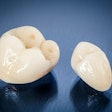
Much like endosseous titanium implants changed the realm of implant dentistry, advances in technology hold the key to solving one of today's most pressing issues in the management of dental implants: peri-implantitis. Though official definitions of what exactly constitutes treatment of peri-implantitis remain up for debate within the dental community, millions of implants are being placed each year in the U.S.
 Samuel Low, DDS.
Samuel Low, DDS.As these numbers rise, it is vital for practitioners to continually seek out the safest and most effective methods for managing inflammation associated with implant surfaces. Over the last several decades, laser dentistry has evolved significantly to deliver minimally invasive treatments for dozens of dental conditions affecting both the hard and soft tissues.
Now, laser dentistry also offers an answer to the concerns around the traditional treatment methods of peri-implantitis, enabling dentists to treat patients more effectively and provide a positive postoperative recovery.
Spectrum of tools
Laser dentistry has evolved to offer a wide spectrum of tools for dentists of all specialties, creating new protocols and treatments for diseases that previously involved extremely invasive procedures. A benefit of dental lasers across the board -- and particularly during the management of peri-implantitis -- is increased visibility during procedures.
As lasers decrease hemorrhaging, they improve access, thus enhancing the accuracy as treatments are being performed. Laser therapy also leads to a quicker recovery for patients, promoting the body's natural healing by stimulating cells (mitochondria) to produce energy, according to a study published in Lasers in Dentistry -- Current Concepts (September 22, 2017).
The same study also showed that lasers can have an antimicrobial effect on laser surfaces and possibly decontaminate these surfaces to enhance osseointegration and soft-tissue attachment. Some mechanical devices can have an adverse effect via damage of the surface and undermine attachment potential.
By using wave-length-specific dental lasers, practitioners are able to decontaminate and detoxify the threads of an implant and prevent bacterial growth on the surface without damaging the surface or surrounding tissue. Certain wavelengths, such as a solid-state yttrium-scandium-gallium-garnet (Er, Cr:YSGG) laser at the 2,780-nanometer (nm) wavelength, also do not significantly impact or alter the implants' surface temperature.
In addition, dental lasers can provide a minimally invasive option that avoids opening flap tissue in mild to moderate cases, allowing for the degranulation of inflamed gingival tissue surrounding an ailing implant.
As the number of patients getting implants increases rapidly, the benefits of laser therapy for the treatment of peri-implantitis are clear. Providers have great opportunity to explore the adoption of patient-friendly, minimally invasive technologies and protocols that allow for new, safer, and more effective treatment of peri-implantitis.
Samuel Low, DDS, is the chief dental officer at Biolase.
The comments and observations expressed herein do not necessarily reflect the opinions of DrBicuspid.com, nor should they be construed as an endorsement or admonishment of any particular idea, vendor, or organization.



















